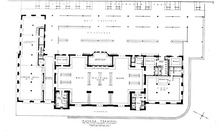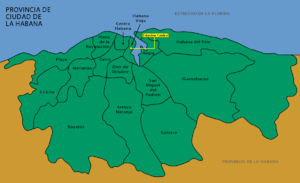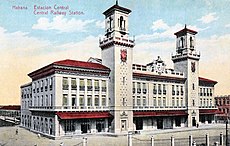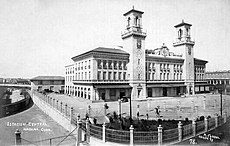|
Havana Central railway station
 Havana Central (Spanish: La Habana Central; the "Central Railway Station", Estación Central de Ferrocarriles) is the main railway terminal in Havana and the largest railway station in Cuba, is the hub of the rail system in the country. It serves for the arrival and departure of national and divisional commuter trains, and is home to the national railway company, Ferrocarriles Nacionales de Cuba (FFCC), the only intercity passenger rail transport operating in the Caribbean.[2] The building is considered a national monument for its architectural and historical values[3] and is, along with the stations of Santiago, Camagüey and Santa Clara, a network's divisional headquarter.[4] Site The site of the railway station is located where the former Spanish Royal Shipyard of Havana was southeast of the Campo de Marte, and immediately outside the southernmost gate of the city. Design The eclectic architecture building has four floors and a mezzanine. On the main facade, there are two towers on Belgica Avenue representing the coat of arms of Cuba and Havana, respectively. The architect was Kenneth MacKenzie Murchison, who was inspired by the decorative style of Spanish Plateresque, which is visible in the elements of the decoration of the facade. The station's platforms are nearly one kilometer long and have a total area of 14,000 square meters. HistoryBy 1910, the 71-year-old Villanueva Railway Station (currently the Capitolio grounds), the first of Havana, had exceeded its capacity due to increasing urban development and population of the city. On July 20, 1910, the Congress of Cuba authorized to build the new railway station on the'Arsenal public grounds instead of the Villanueva Station private grounds. The value of the old arsenal grounds and buildings was about US$3.7 million at the time, while the Villanueva grounds were about $2.3 million. This transaction caused heated debates within the political community and in general throughout the population of the city, because the value of Arsenal land was more than a million dollars to Villanueva, so it was unknown where that amount would go. This resulted in heated debates in the Congress. The Chamber representative Silverio Sánchez Figueras, commander of the liberation army, denounced the trade as a "dirty business", and the action was contradicted by congressman Colonel Severo Moleón Guerra. The confrontation culminated in a duel to death on December 9, 1910, where Congressman Moleón died.[5] Two years later, on November 30, 1912, the new Central Railway Station was opened on the former Arsenal grounds. In June 2015, the station closed for a three-year rebuild including additional platforms. All passenger traffic moved to the adjacent Coubre yard, where a former bus terminal was converted into a temporary station.[6] ServiceOverviewCentral Railway Station has a network of suburban, interurban and long-distance rail lines. The railways are nationalised and run by the FFCC (Ferrocarriles de Cuba – Railways of Cuba). Rail service connects the Central Rail Station to various Cuban provinces. In 2009, the annual passenger volume was roughly 7.5 million,[1] almost 400,000[1] less from the previous year, and 3.5 million[1] less than 2004, mainly after the government upgraded ASTRO's long-distance inter-city buses fleet with brand new air conditioned Yutong buses. Santiago de Cuba is the busiest route from the Central Station, some 836 kilometres (519 mi) apart by rail. In 2000 the Union de Ferrocarriles de Cuba bought French first class air conditioned coaches. Fast trains line 1 and 2, between (Central Station) and Santiago de Cuba, use comfortable stainless-steel air-conditioned coaches bought from French Railways and now known as the "Tren Francés" (the French train). It runs daily at peak periods of the year (Summer season, Christmas & Easter), and on every second day at other times of the year. These coaches were originally used on the premier Trans Europ Express service between Paris, Brussels and Amsterdam before being replaced with high speed Thalys trains. They were shipped to the Cuban Railways System in 2001. It offers two classes of seating, basic leatherette "especial" and quite luxurious "primera especial". Route diagrams

Gallery
See also
References
External links
|
||||||||||||||||||||||||||||||||||||||||||||||||||||||||||||||||||||||||||||||||||||||||||||||||||||||||||||||||||||
Portal di Ensiklopedia Dunia







